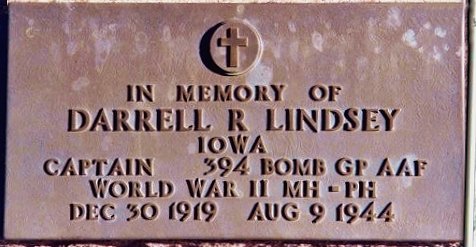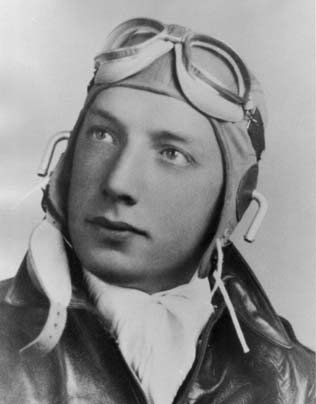Darrell Robins Lindsey 587,825
- Born: 30 December 1919, Jefferson, Greene County, Iowa 825,2374,2375,2376
- Marriage: Evalyn Lo Sadie Scott between 1940 and 1944
- Died: 9 August 1944, L'Isle Adam, France at age 24 587,2374,2376
- Buried: After 9 August 1944, Jefferson, Greene County, Iowa at Jefferson Cemetery


Jasper van Haren of the Netherlands has adopted the grave of Capt. Darrell Robins Lindsey <http://www.fieldsofhonor-database.com/index.php/american-war-cemetery-ardennes-l/44038-lindsey-darrell-r> and holds an adoption certificate. He can be reached by e-mail at <jappieyo at hotmail.com>.
Mr. van Haren has compiled and authored the following story, which I paste below, but may be directly accessed at:
<http://www.heroesforever.nl/Darrell%20R%20Lindsey.htm>
*****
Darrell Robins Lindsey was born in Jefferson, Iowa on December 30, 1919. His parents were Jesse Lyle and Grave [sic] Alice Lindsey. Darrell had one brother, Lyle F. Lindsey, who was 2 years older than Darrell. After attending Buena Vista University from 1937 to 1941, he enlisted as an aviation cadet at Fort Des Moines, Iowa, January 16, 1942. He trained at Visalia, Lemoore, and Victorville Fields, California, receiving his pilot's wings and commission as a second lieutenant in August 1942.
In addition to pilot training, Lindsey was also trained as a bombardier at Kirtland Field, New Mexico, and in 1943 was assigned to the 314th Bomb Squadron at MacDill Field, Florida, with rank of first lieutenant. He was transferred to Kellogg Field, Michigan, in September 1943, and assigned to the 585th Bomb Squadron, 394th Bomb Group (Medium), a B-26 Marauder outfit. Promoted to captain in December 1943, he was assigned as a flight commander.
In early 1944, the 394th Bombardment Group flew its B-26 Martin Marauders from Kellogg Field, Michigan, to England. The 394th entered combat in March, joining other medium bomb groups and fighter-bombers in attacking German defenses and transportation in preparation for the invasion that everyone (Germans and Allies alike) knew was coming. After D-Day, the 394th continued to bomb targets in northern France, supporting the Allied advance from the Normandy beachheads.
On August 7, the Germans launched a counteroffensive aimed at securing Avranches, on the west coast of France. There they hoped to anchor a line that would confine the Allies to areas already held in Normandy and the Cotentin Peninsula. A key element for the German armies was transportation to move desperately needed supplies and reinforcements to the front. Most of the bridges over the Seine had been knocked out. One link that remained was the railroad bridge over the Oise River at L'Isle Adam, a few miles north of Paris. It was heavily defended by many batteries of 88-mm guns (a major threat to the B-26s that normally bombed from an altitude of 10,000 to 12,000 feet).
Ninth Air Force sent the 394th against the bridge on August 9, 1944. Leading 30 B-26s was 25-year-old Captain Darrell Lindsey, one of the group's veteran pilots. This was Lindsey's 46th mission, bringing him to 143 combat hours. He was known for his skill as a pilot and for coolness under fire. Both would be tested that day.
On reaching enemy territory, the formation encountered heavy flak, which continued with few interruptions as they approached the target area. Lindsey maneuvered the bombers past successive barrages with only minor damage. Before starting the bomb run, Lindsey's lead plane was hit, but was able to hold course. Worse was yet to come. On the bomb run, his right engine took a direct hit and burst into flame. The concussion hurled the B-26 out of formation, but Lindsey regained control and resumed the lead, his right wing sheathed in flame. The wing tank could explode at any moment, but rather than giving the signal to bail out and disrupt the formation at this critical point, Lindsey elected to continue the attack. This was a target that could help turn the tide of battle in Normandy.
Immediately after "bombs away," Lindsey ordered the crew to jump while he held the flaming Marauder in a steady descent. The last crewman to leave the plane was the bombardier. As he crawled out of the nose, he shouted that he would lower the landing gear so Lindsey could bail out from the nose of the aircraft.
Using all his piloting skill, Lindsey was barely able to keep control of the doomed bomber, its right wing now totally engulfed in flame. He knew that lowering the gear might throw the plane into an uncontrollable spin, probably making it impossibie for the bombardier to bail out. He told the man to leave through a waist window while the aircraft was still under control. By all logic, the tank should have blown by this time. It might hold long enough for the bombardier to jump. lt did, but before Captain Lindsey could leave the cockpit, the wing tank exploded. The B-26 went into a steep dive and hit the ground in a bail of fire.
For destroying four railroad bridges and an ammunition dump between August 7 and 9, 1944, the 394th Group received a Distinguished Unit Citation. On May 30, 1945, Captain Darrell R. Lindsey was awarded the Medal of Honor posthumously for his heroism and self-sacrifice on August 9, 1944. The Medal was accepted by his widow, Evelyn. Captain Lindsey was the only Marauder crew member to be so honored in World War II.
Uncharacteristic of the formal, stilted citations for combat awards, the citation for Lindsey's Medal of Honor ends with these words: "All who are living today from this plane owe their lives to the fact that Captain Lindsey remained cool and showed supreme courage in this emergency." For him, completing the mission came first, the safety of his crew second, his own survival last. He was a leader in the finest tradition of the American military services.
In November 1946 Lindsey Air Station, Wiesbaden Air Base, Germany, was named in Captain Lindsey's memory and served as the location of the Headquarters for the United States Air Forces in Europe. The station closed in 1993 and a red granite monument there was returned to Jefferson, Iowa, and placed on the lawn of the Greene County Courthouse, where it was dedicated to Lindsey on June 12, 1993.
Captain Darrell R. Lindsey 's name is written at the Tablets of the Missing at Ardennes American Cemetery in Neupre, Belgium.
The adoptant of Captain Darrell R. Lindsey 's grave, Jasper van Haren, is searching for more information about Darrell R. Lindsey. Every kind of information is more than welcome. You can contact Jasper van Haren at: jappieyo@hotmail.com
*****
Other links:
http://www.b26.com/marauderman/darrell_lindsey.htm
http://www.homeofheroes.com/moh/citations_1940_wwii/lindsey_darrell.html
http://www.homeofheroes.com/gravesites/states/pages_go/lindsey_darrell_ia.html

 Events Events
• He appeared on the census in 1920 in Jefferson, Greene County, Iowa. He lived in the household of his parents and grandparents.
• He appeared on the census in 1925 in Jefferson, Greene County, Iowa. He lived in the household of his parents.
• He appeared on the census in 1930 in Grinnell, Poweshiek County, Iowa. He lived in the household of his parents.
• He appeared on the census in 1940 at 1610 2nd Avenue North in Fort Dodge, Webster County, Iowa. He lived in the household of his parents.
• He served in the U.S. Airforce during World War II.
• He received the Medal of Honor after being killed in action during World War II in France.

• He was buried at Jefferson Cemetery in Jefferson, Greene County, Iowa.

Darrell married Evalyn Lo Sadie Scott, daughter of Merle Milton Scott and Eva Allen Seaman, between 1940 and 1944. (Evalyn Lo Sadie Scott was born 31 October 1919 in Sioux City, Woodbury County, Iowa,2377,2378,2379 died 17 August 1992 in New Mexico 2377,2379,2380 and was buried after 17 August 1992 in Sac City, Sac County, Iowa at Cory Grove Cemetery 2379.) The cause of her death was due to an accident while traveling back to Iowa from New Mexico.
|



